|
Film, Radio and TV - 24 |
|
Television's
World War II Puts TV "On Hold" Then World War II came along. Everything stopped until 1945, as U.S. industry moved into large-scale production of armaments and related materials. Once the war ended, some 70 stations immediately went on the air. Things expanded rapidly until 1948. At that point the FCC saw that the number of available TV channels (2-13 on the VHF band) wasn't going to meet the demand for new stations. To have time to sort out the problem they initiated a four-year freeze on issuing new TV station licenses.
The solution the FCC came up with was to authorize the use of a whole new group of channels. In 1952, they launched UHF television (ultra high frequency, channels 14–83) and lifted the freeze. Their plan provided for 2,053 stations in 1,291 communities in the U.S. and its territories. Channel assignments in 242 communities were set aside for noncommercial and educational purposes. Since the UHF band represented much higher frequencies
than the original VHS channels, it presented some unique problems--not
the least of which was the fact that existing TV sets could not receive
any of these channels. The FCC then mandated that all new TV sets manufactured must have the ability to receive both VHS and UHF channels. Owners of existing receivers had to buy a special tuner if they wanted to see UHF stations. Viewers quickly discovered that UHF stations were much harder to tune in than VHF stations, and for most people the new UHF channels required a special antenna. To make things even more complicated, some TV markets had all VHF stations; some all UHF; and some had both types. In markets that had both VHF and UHF channels, people tended to just stick with VHF, since it was a lot easier. But, there were even more problems for UHF stations; they require far more transmitter power to cover a given area, and, compared to VHF, their signals tend to encounter more reception problems. All of this, of course, meant that UHF stations had a major disadvantage. Many UHF stations in VHF/UHF markets "went dark" (ceased operations) because they simply couldn't generate enough revenue to stay on the air. A commercial UHF station in San Francisco was sold to a public station for one dollar. Today, many of the UHF problems have been solved with new types of TV sets and the wide use of cable. (Cable television makes all TV stations equal, regardless of frequency or power.) Incidentally, when digital/high-definition television was in the
planning stage in the 1990s, the FCC decided to take over a large
(and mostly unused) chunk of the UHF spectrum for this new technology.
Today, there are more than 800 digital/high-definition stations on
the air in the United States. You can find out more about this new
type of television |
|
Television in European After World War II, the BBC (British Broadcasting System) launched an ambitious plan for providing television service for 80 percent of Great Britain. In 1949, they completed construction on the most powerful TV transmitter in the world. Eight other BBC stations were completed in 1952. A little more than 25 years later, 98 percent of the population had a TV set in their homes. In Canada, where experiments in television had started in the 1930s, regular TV broadcasting was launched by CBC (Canadian Broadcasting Corporation) station CBFT in Montreal in September, 1952. Only three years later, television was available to 66 percent of the Canadian population. Three years after that Canada telecast its first "live," coast-to-coast program on a newly completed television network. One of the major problems Canada has is producing a full range of programs in both English and French. This means that when both the CBC and the many independent stations are considered, Canada produces more hours of radio and television programming than most any other country.
By the late 1980s, more than 90 percent of households in Italy and West Germany had television receivers; and 98 percent of British, French and Russian households had TV sets. Except for Canada, all of these countries use a different broadcast system than the United States. Starting later than the United States, these European countries were able to devise systems that, in terms of clarity, were superior to the U.S. system--and totally incompatible with it. This also meant that TV receivers (and later, videotape machines) sold in one country often could not be used in another country. Incompatible television standards also created major problems for
selling U.S. TV programs to European countries. (The export of film
and TV entertainment programming is one of the largest exports for
the United States.) More information on world TV systems can be
By 1952, AT&T began to electronically link the east and west coasts of the United States. Having coast-to-coast connections had a major impact on the TV industry--even more, in fact, that the radio networks had on radio. Before this time the only way that a TV program could be distributed to stations across the country was to use a movie camera to photograph the program from a TV screen (a kinescope recording) and then send copies of the film to individual stations. In addition to representing a major delay, the somewhat blurry, black and white kinescope recordings were less than appealing. Nightly network TV newscasts that originated on the East Coast were sent to West Coast stations by kinescope recordings. After the newscast was filmed, the film was put on a plane, processed as the plane flew across the country, and then delivered several hours later to West Coast stations. When AT&T finished linking the east and
west coasts, all this changed. From then on, programming that was
produced on either the east or west coasts (where most TV programming
originates) could be sent "live" over network lines to stations throughout
the country. In 1956,
In that year, 67 percent of homes had a black and white TV receiver (color had not hit the scene yet). Just five years after that the figure had reached 87 percent. Television had now taken the place of radio as the family's evening focal point. In a short time the viewing public
wanted more TV channels To meet this need, the first step was to build new TV stations.
When the satellite relay of TV signals became possible, a profusion
of satellite services, including HBO, Showtime, and many other specialty
channels, became available. The satellite distribution of TV signals
is discussed in more detail The graph on the right shows how the number of TV channels rapidly increased after 1980. In the next module we'll follow the history of television into the present era. |
|
To
next module To
index © 1996 - 2005, All Rights Reserved.
|
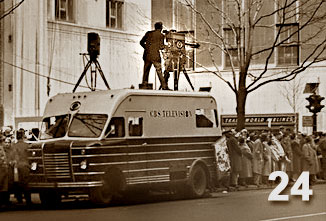
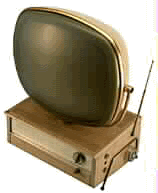
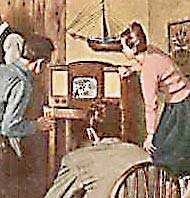 Although
France and the Netherlands also initiated TV broadcasting soon after
the war, it was Russia (specifically Moscow), in 1948 that first initiated
regular continental broadcasts.
Although
France and the Netherlands also initiated TV broadcasting soon after
the war, it was Russia (specifically Moscow), in 1948 that first initiated
regular continental broadcasts.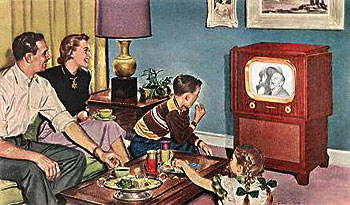 By
1955, the cost of TV sets had come down considerably. Instead of being
equal to half the price of a car, they were now just equal to the
cost of a new set of tires.
By
1955, the cost of TV sets had come down considerably. Instead of being
equal to half the price of a car, they were now just equal to the
cost of a new set of tires. 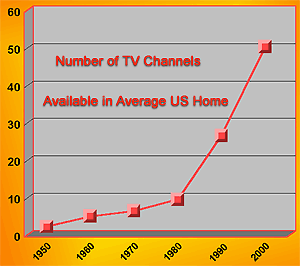 (no doubt as they got tired of watching reruns on the basic channels).
(no doubt as they got tired of watching reruns on the basic channels).